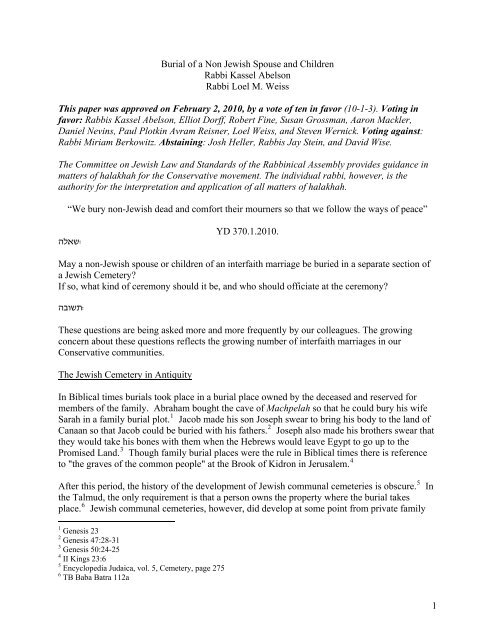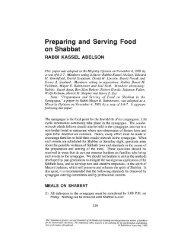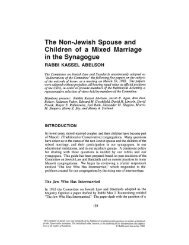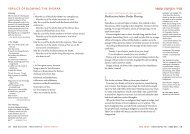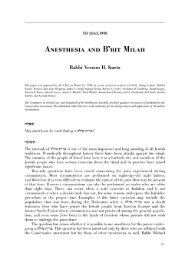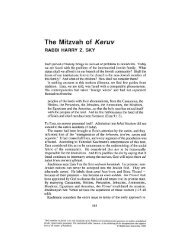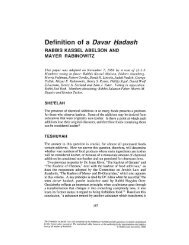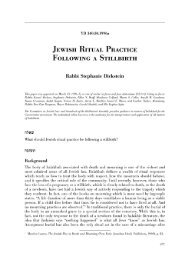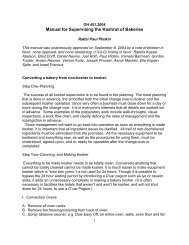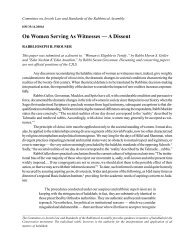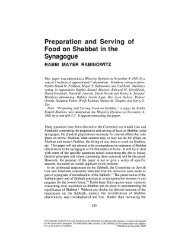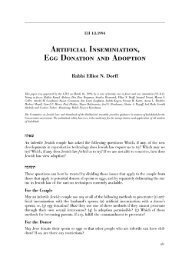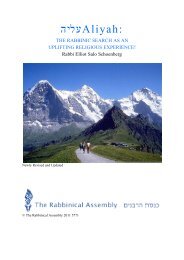Burial of a Non Jewish Spouse and Children - The Rabbinical ...
Burial of a Non Jewish Spouse and Children - The Rabbinical ...
Burial of a Non Jewish Spouse and Children - The Rabbinical ...
Create successful ePaper yourself
Turn your PDF publications into a flip-book with our unique Google optimized e-Paper software.
<strong>Burial</strong> <strong>of</strong> a <strong>Non</strong> <strong>Jewish</strong> <strong>Spouse</strong> <strong>and</strong> <strong>Children</strong><br />
Rabbi Kassel Abelson<br />
Rabbi Loel M. Weiss<br />
This paper was approved on February 2, 2010, by a vote <strong>of</strong> ten in favor (10-1-3). Voting in<br />
favor: Rabbis Kassel Abelson, Elliot Dorff, Robert Fine, Susan Grossman, Aaron Mackler,<br />
Daniel Nevins, Paul Plotkin Avram Reisner, Loel Weiss, <strong>and</strong> Steven Wernick. Voting against:<br />
Rabbi Miriam Berkowitz. Abstaining: Josh Heller, Rabbis Jay Stein, <strong>and</strong> David Wise.<br />
<strong>The</strong> Committee on <strong>Jewish</strong> Law <strong>and</strong> St<strong>and</strong>ards <strong>of</strong> the <strong>Rabbinical</strong> Assembly provides guidance in<br />
matters <strong>of</strong> halakhah for the Conservative movement. <strong>The</strong> individual rabbi, however, is the<br />
authority for the interpretation <strong>and</strong> application <strong>of</strong> all matters <strong>of</strong> halakhah.<br />
“We bury non-<strong>Jewish</strong> dead <strong>and</strong> comfort their mourners so that we follow the ways <strong>of</strong> peace”<br />
vkta:<br />
YD 370.1.2010.<br />
May a non-<strong>Jewish</strong> spouse or children <strong>of</strong> an interfaith marriage be buried in a separate section <strong>of</strong><br />
a <strong>Jewish</strong> Cemetery?<br />
If so, what kind <strong>of</strong> ceremony should it be, <strong>and</strong> who should <strong>of</strong>ficiate at the ceremony?<br />
vcua,:<br />
<strong>The</strong>se questions are being asked more <strong>and</strong> more frequently by our colleagues. <strong>The</strong> growing<br />
concern about these questions reflects the growing number <strong>of</strong> interfaith marriages in our<br />
Conservative communities.<br />
<strong>The</strong> <strong>Jewish</strong> Cemetery in Antiquity<br />
In Biblical times burials took place in a burial place owned by the deceased <strong>and</strong> reserved for<br />
members <strong>of</strong> the family. Abraham bought the cave <strong>of</strong> Machpelah so that he could bury his wife<br />
Sarah in a family burial plot. 1 Jacob made his son Joseph swear to bring his body to the l<strong>and</strong> <strong>of</strong><br />
Canaan so that Jacob could be buried with his fathers. 2 Joseph also made his brothers swear that<br />
they would take his bones with them when the Hebrews would leave Egypt to go up to the<br />
Promised L<strong>and</strong>. 3 Though family burial places were the rule in Biblical times there is reference<br />
to "the graves <strong>of</strong> the common people" at the Brook <strong>of</strong> Kidron in Jerusalem. 4<br />
After this period, the history <strong>of</strong> the development <strong>of</strong> <strong>Jewish</strong> communal cemeteries is obscure. 5 In<br />
the Talmud, the only requirement is that a person owns the property where the burial takes<br />
place. 6 <strong>Jewish</strong> communal cemeteries, however, did develop at some point from private family<br />
1 Genesis 23<br />
2 Genesis 47:28-31<br />
3 Genesis 50:24-25<br />
4 II Kings 23:6<br />
5 Encyclopedia Judaica, vol. 5, Cemetery, page 275<br />
6 TB Baba Batra 112a<br />
1
cemeteries. Communal cemeteries may have started in the Babylonian exile, because the<br />
l<strong>and</strong>scape was essentially flat, <strong>and</strong> there were few caves available for families to purchase <strong>and</strong><br />
use for the private burial <strong>of</strong> family members. Through the Middle Ages <strong>and</strong> into the modem era<br />
Jews developed cemeteries in most communities where they settled. 7<br />
'ovk sjuhn ,urce ,hc ovk ,uhvk 'ktrah hbc kg ubh,ucr ukhyv ause cuj<br />
jkak tka 'vz kg ujhdah ,ubye ,ukhve ukhptu 'ovka gerev vhvhau<br />
[swwk swwruh ejmh ihg] ,rjt rhgk ivh,n<br />
“Our Rabbis put a holy obligation on the children <strong>of</strong> Israel, to have special<br />
graveyards for themselves, that they should own the ground, <strong>and</strong> even small<br />
communities should be strict about this, so that they do not have to send their<br />
dead to another city.”<br />
<strong>Jewish</strong> communal cemeteries were generally reserved for the burial <strong>of</strong> Jews. It was not until<br />
around the nineteenth century that <strong>Jewish</strong> cemeteries became part <strong>of</strong> larger community<br />
cemeteries <strong>and</strong> st<strong>and</strong>ards distinguishing <strong>Jewish</strong> burial grounds from general burial grounds were<br />
fixed. 8 With these facts in mind we turn to the texts that shed light on the question <strong>of</strong> whether<br />
non-<strong>Jewish</strong> spouses may be buried in <strong>Jewish</strong> communal cemeteries.<br />
<strong>The</strong> Basic Source<br />
In the Talmud, the reference to <strong>Jewish</strong> <strong>and</strong> non <strong>Jewish</strong> burial is: 9<br />
ohrfb hkuj ihrecnu 'ktrah hhbg og ohrfb hhbg ohxbrpn :r",<br />
'ktrah h,n og ohrfb h,n ihrcueu 'ktrah hkuj og<br />
/ouka hfrs hbpn<br />
“We support the indigent <strong>of</strong> the non-Jews with the indigent <strong>of</strong> the Jews <strong>and</strong> we<br />
visit the sick <strong>of</strong> the non-Jews with the sick <strong>of</strong> the Jews <strong>and</strong> we bury the dead <strong>of</strong><br />
the non-Jews with the dead <strong>of</strong> the Jews because <strong>of</strong> the ways <strong>of</strong> peace.”<br />
Rashi’s 10 Interpretation<br />
outmn ot ovc ihexg,n tkt ktrah hrcec tk -ktrah h,n og<br />
/ktrah og ohdurv<br />
“Not in <strong>Jewish</strong> graves. Rather we can involve ourselves in their burial when they<br />
are found killed with Israel.”<br />
7 Ain Yitzchak YD 34, Kol Bo Al Availut Chapter III, Siman Aleph. Use <strong>of</strong> this text was suggested by Rabbi<br />
Avram Reisner.<br />
8 Encyclopedia Judaica, vol 5, Cemetery, page 275. “During the last century many cities in Europe established<br />
communal cemeteries in which separate sections were provided for different faiths. Leading rabbinical authorities<br />
held that if the <strong>Jewish</strong> section is given to the <strong>Jewish</strong> community as a permanent possession, this section may be used<br />
as a <strong>Jewish</strong> burial ground but must be fenced-<strong>of</strong>f with a space <strong>of</strong> four cubits between the <strong>Jewish</strong> <strong>and</strong> the general<br />
section. (M. Deutsch, Duda’ei ha-Sade [I no. 66])”<br />
9 TB Gittin 61a<br />
10 Rabbi Shlomo ben Yitzchak, (1040-1105), France, commentary to TB Gittin 61a.<br />
2
Rashi makes it clear that non-Jews are not to be buried in <strong>Jewish</strong> graves <strong>and</strong> we only involve<br />
ourselves in the burial <strong>of</strong> non-Jews when they are found side by side with <strong>Jewish</strong> dead.<br />
<strong>The</strong> Beit Yosef 11 suggests that Rashi is basing his interpretation on the text from Sanhedrin 47a,<br />
ehsm kmt gar ihrcue ihta hpk "that we don’t bury the wicked ‘next to’ the righteous. And if<br />
we don’t bury wicked Jews next to the righteous, then we certainly wouldn’t consider burying<br />
non-Jews next to Jews.” 12<br />
<strong>The</strong> Tosefta 13 says.<br />
hscugnu ktrahn ihcud ihxbrpv ohcfuf hscugu ktrah vc aha rhg<br />
ktrah [hhbgu] ohcfuf hscug hhbg ihxbrpnu ouka hfrs hbpn ohcfuf<br />
ohcfuf hscug h,n ihrcueu [ihshpxn] ouka hfrs hbpn<br />
:ouka hfrs hbpn ohcfuf hscug hkhct [ihnjbn] ouka hfrs hbpn<br />
“In a city where there are both Jews <strong>and</strong> Idol worshippers, the Charity Collectors<br />
collect from both Jews <strong>and</strong> Idol worshippers for the sake <strong>of</strong> peace <strong>and</strong> we provide<br />
sustenance for the poor <strong>of</strong> the Idol worshippers <strong>and</strong> the (poor) <strong>of</strong> the Jews for the<br />
sake <strong>of</strong> peace <strong>and</strong> we (eulogize) <strong>and</strong> bury the dead <strong>of</strong> the Idol Worshippers for the<br />
sake <strong>of</strong> peace <strong>and</strong> we (comfort) the mourners <strong>of</strong> Idol Worshippers for the sake <strong>of</strong><br />
peace.”<br />
<strong>The</strong> Tosefta leaves out the words, “with the dead <strong>of</strong> the Jews”.<br />
Interpreting Rashi<br />
A number <strong>of</strong> commentators (for example the Kesef Mishnah 14 on Hilchot Melachim, 15 the Beit<br />
Yosef 16 <strong>and</strong> the Bach 17 ) add that the Ran 18 disagrees with Rashi. Perhaps basing his reasoning<br />
11 Rabbi Yosef Caro, (1488-1575) Safed, commentary to Shulkhan Aruch, YD 367.<br />
12 Rabbi Ben Zion Bergman wrote, “<strong>The</strong> Conservative Movement has categorically rejected the idea that non-Jews<br />
are by definition ‘evil’. "Whatever may have been the justification for such a presumption in times past, I find such<br />
a presumption today ethically <strong>of</strong>fensive. This is particularly so, since the statement in its original context (Sanhedrin<br />
47a) is used to explain why Harugai Bet Din (those executed by the court} were buried separately. In other words,<br />
in the original context the Rasha is an executed criminal.” Furthermore, <strong>Jewish</strong> tradition also teaches us;<br />
tcv okugk ekj ovk ah okugv ,unut hshxj<br />
"<strong>The</strong> righteous <strong>of</strong> the nations <strong>of</strong> the world have a share in the world to come", that not all non-Jews are r'sha-im<br />
(wicked). Certainly a non-<strong>Jewish</strong> spouse, who may have contributed services to the synagogue, provided the<br />
children with a <strong>Jewish</strong> education <strong>and</strong> is not being buried with Christian burial rites or sacraments should not be<br />
presumptively characterized as a rasha (wicked person)." See Bergman, Ben Zion, A Matter <strong>of</strong> Grave Concern, in<br />
Responsa, <strong>The</strong> Committee on <strong>Jewish</strong> Law <strong>and</strong> St<strong>and</strong>ards <strong>of</strong> the Conservative Movement, 1991-2000. Ed. Kassel<br />
Abelson <strong>and</strong> David J. Fine, <strong>The</strong> <strong>Rabbinical</strong> Assembly, 2002, pp. 418-425.<br />
Orthodox Poskim as well, reject this view. (See Greenwald, Yekutiel, Kol Bo Al Avelut, vol. 1, p.194 <strong>and</strong> Feinstein,<br />
Moshe, Iggerot Moshe, YD. vol. 1, #60). Eliezer Hausd<strong>of</strong>f, Responsum in Regard to the <strong>Burial</strong> <strong>of</strong> a <strong>Non</strong>-Jew in a<br />
<strong>Jewish</strong> Cemetery, Leipzig, 1888, writes: “…he has a right to say that he does not care who is buried by his side; <strong>and</strong><br />
on his own property, he may bury whom he wishes. <strong>The</strong>re is no actual legal prohibition involved.”<br />
13 Gittin 3:18<br />
14 Op. cit., Footnote #11.<br />
3
on the Tosefta, he says that we can bury the dead <strong>of</strong> the non-Jew <strong>and</strong> eulogize the non-Jew <strong>and</strong><br />
comfort the mourners <strong>of</strong> the non-Jew, even if he is not found together with <strong>Jewish</strong> dead. 19<br />
Rambam 20 also leaves out the words ktrah h,n og, yet in Hilchot Melachim 21 (10.12), he<br />
includes these words going so far as to say;<br />
ktrah h,n og ovh,n ruceku wovhkuj reck ohnfj uum o"ufgv ukhpt<br />
“And even with the Idol Worshipper, our sages comm<strong>and</strong> us to visit their sick <strong>and</strong><br />
bury their dead with the dead <strong>of</strong> Israel.”<br />
<strong>The</strong> Tur 22 adds the following:<br />
קוברים מתי נכרים עם מתי ישראל ומנחמין אבליהם מפני דרכי שלום ופירש"י לא שיקברום בקבר<br />
ישראל אלא משתדלים בקבורתם כמו שמשתדלים בקבורת ישראל<br />
“We bury the non-<strong>Jewish</strong> dead with the dead <strong>of</strong> Israel <strong>and</strong> we comfort their<br />
mourners for the ways <strong>of</strong> peace. According to Rashi, ‘we do not bury them in<br />
<strong>Jewish</strong> cemeteries, but we involved ourselves in their burial just like we involve<br />
ourselves in the burial <strong>of</strong> Israel.’”<br />
<strong>The</strong> Shukhan Aruch 23 leaves out the words from the Gemara, ktrah h,n og.<br />
<strong>The</strong> Tur 24 <strong>and</strong> the Shulkhan Aruch 25 say;<br />
מותר לפרנס ענייהם ולבקר חוליהם ולקבור מתיהם ולהספידן ולנחם אבלים משום דרכי שלום:<br />
“It is permitted to support their poor, visit their sick, bury their dead, eulogize <strong>and</strong><br />
comfort mourners for the sake <strong>of</strong> peace.”<br />
<strong>The</strong> Bach on the Tur 26 , is the one classical commentator who seems to permit the burial <strong>of</strong><br />
Jews <strong>and</strong> non-Jews together.<br />
15 Mishnah Torah, Hilchot Melachim 10.12.<br />
16 Tur YD 367.<br />
17 Rabbi Yoel Sirkes, (1561-1640), Pol<strong>and</strong>. Commentary to Shulkhan Aruch YD 151.<br />
18 Rabbi Nissim ben Yakov, 14 th century, Spain. Rabbi Nissim’s view is what has informed the decision <strong>of</strong> the<br />
<strong>Jewish</strong> Welfare Board to permit the burial <strong>of</strong> fallen <strong>Jewish</strong> servicemen in battle together with their non-<strong>Jewish</strong><br />
comrades in National Cemeteries. “Responsa in War Time, National <strong>Jewish</strong> Welfare Board, 1947. p.83.<br />
19 We thank Rabbi Avram Reisner for suggesting this interpretation.<br />
20 Moshe ben Maimon (Maimonides), (1135-1204), Spain, Egypt, Mishnah Torah, Hilchot Evel, 14.12.<br />
21 Mishnah Torah, Hilchot Melachim 10.12.<br />
22 Yakov ben Asher, (1270-1340), Spain. YD. 367.<br />
23 YD 367.1.<br />
24 YD 151.<br />
25 YD 151.12.<br />
26 YD 151.<br />
4
He quotes Rashi who only permits burial <strong>of</strong> non-Jews when they are found on the battlefield<br />
together with Jews, <strong>and</strong> he says (following the Ran), “Not necessarily, for it is the law that<br />
whenever we find non-<strong>Jewish</strong> dead we involve ourselves in (their burial) for the sake <strong>of</strong> peace.”<br />
He then asks why Maimonides in Hilchot Melachim, leaves out the words ktrah h,n og while<br />
in Hilchot Avel he adds them.<br />
“It is to teach that just as we support the non-<strong>Jewish</strong> poor by themselves even<br />
when there are no <strong>Jewish</strong> poor, we can bury the non-<strong>Jewish</strong> dead by themselves<br />
wherever they are found even when there are no <strong>Jewish</strong> dead. And just as we<br />
support the non-<strong>Jewish</strong> poor together with the <strong>Jewish</strong> poor, we can bury the non-<br />
<strong>Jewish</strong> dead together with the <strong>Jewish</strong> dead.”<br />
But the Bach goes even further saying:<br />
ktrah hrcec ovh,n rucek kufh ktrah og ohdurv outmn ots<br />
iht gar ktrah ukhpts ktrah kmt hrfb ohrcue ihta epx ihts dwwgtu<br />
rucek tuv kufh nwwn iwwrv c,fsfu ktrah kmt hrfb awwf ehsm kmt ohrcue<br />
/ouka hfrs hbpn sjt rmjc ktrah h,n og hrfb h,n<br />
“And if we find their dead killed with Israel, we can bury their dead in the graves<br />
(cemetery) <strong>of</strong> Israel even though the Ran says it’s clear that we don’t bury non-<br />
Jew next to a Jew for we don’t bury a wicked Jew next to a righteous one even<br />
more so we don’t bury a non-Jew next to a Jew. However, (the Bach continues)<br />
we can bury the non-<strong>Jewish</strong> dead with the <strong>Jewish</strong> dead in the same courtyard for<br />
the sake <strong>of</strong> peace.”<br />
<strong>The</strong> Bach, following the Ran, permits Jews to be involved in the burial <strong>of</strong> non-Jews EVEN when<br />
there are no <strong>Jewish</strong> dead. And he permits the burial <strong>of</strong> non-Jews together with Jews, in the same<br />
courtyard (cemetery). <strong>The</strong>re are differing opinions as to whether the Bach would permit the<br />
burial <strong>of</strong> non-Jews together with Jews only if they were killed together or even if they were not<br />
killed together.<br />
<strong>The</strong> Arukh HaShulkhan 27 adds that when we see their dead, we st<strong>and</strong> <strong>and</strong> we eulogize their dead<br />
for the sake <strong>of</strong> peace.<br />
Even though Rashi limits the applicability <strong>of</strong> the Gemara to situations where <strong>Jewish</strong> <strong>and</strong> non-<br />
<strong>Jewish</strong> dead are found together, as we have shown, a number <strong>of</strong> the traditional commentators<br />
(Tur, Kesef Mishnah, Ran) permit the burial <strong>of</strong> non-Jews even when there are no <strong>Jewish</strong> dead.<br />
<strong>The</strong> Bach goes even further <strong>and</strong> permits the burial <strong>of</strong> non-Jews in the same courtyard (cemetery)<br />
where Jews are buried.<br />
Conservative Teshuvot on Related Issues<br />
27 Rabbi Yechiel Michel Epstein, (1829-1907), Lithuania, YD 367.<br />
5
In years past the Committee on <strong>Jewish</strong> Law <strong>and</strong> St<strong>and</strong>ards (CJLS) dealt with questions closely<br />
related to the question. Two Teshuvot point the way to dealing with the question <strong>of</strong> the burial <strong>of</strong><br />
non-<strong>Jewish</strong> spouses in <strong>Jewish</strong> cemeteries but do not give a definitive answer. Rabbi Ben Zion<br />
Bergman wrote a Teshuvah entitled "A Matter <strong>of</strong> Grave Concern: A Question <strong>of</strong> Mixed<br />
<strong>Burial</strong>." 28 Rabbi Myron Geller wrote "Peaceful Paths: <strong>Burial</strong> <strong>of</strong> <strong>Non</strong>-Jews in a <strong>Jewish</strong> Cemetery<br />
Following a Common Disaster" 29<br />
Israel also must grapple with the question <strong>of</strong> burying non-Jews in a <strong>Jewish</strong> cemetery. This<br />
question was raised concerning the burial <strong>of</strong> Olim from the FSU in a new cemetery in Beer<br />
Sheva. Rabbi David Golinkin, writing for the Va'ad Halakha <strong>of</strong> the <strong>Rabbinical</strong> Assembly in<br />
Israel wrote a Teshuvah entitled "<strong>The</strong> <strong>Burial</strong> <strong>of</strong> <strong>Non</strong>-Jews in a <strong>Jewish</strong> Cemetery.” 30<br />
Each <strong>of</strong> the Teshuvot approaches the issue from a different vantage point, <strong>and</strong> sheds light on the<br />
issues with which we must deal.<br />
Concerning Rashi's interpretation <strong>of</strong> the Talmud cited above, Rabbi Geller exp<strong>and</strong>s on this in his<br />
Teshuvah:<br />
" ... Rashi <strong>and</strong> others limit its application to a common disaster when non-Jews <strong>and</strong> Jews<br />
are found dead along side each other (B. Gittin 61a). Rashi underst<strong>and</strong>s the Baraita to refer to a<br />
situation in which the identification <strong>of</strong> the faith group <strong>of</strong> each <strong>of</strong> the cadavers is possible <strong>and</strong> the<br />
Rabbis are concerned about the unseemliness <strong>of</strong> Jews carrying away their own dead for burial<br />
while ab<strong>and</strong>oning the non-<strong>Jewish</strong> dead. Only in these circumstances <strong>and</strong> ouka hfrs hbpn (so<br />
that we follow peaceful paths), does Rashi acknowledge a <strong>Jewish</strong> obligation to non-<strong>Jewish</strong> dead.<br />
It is restricted to burial alone, but interment in a <strong>Jewish</strong> cemetery is not permitted. However, if<br />
non-<strong>Jewish</strong> dead are found without <strong>Jewish</strong> dead nearby, no obligation falls on Jews to undertake<br />
their burial. <strong>The</strong> later authorities accepted Rashi's interpretation that non-Jews were not to be<br />
buried together with Jews. This became the accepted practice down to modern times.<br />
Rabbi Geller's Teshuvah, however, deals with a terrorist incident where the body parts <strong>and</strong> limbs<br />
<strong>of</strong> Jews <strong>and</strong> gentiles are so mangled they cannot be identified for burial. May these limbs <strong>and</strong><br />
body parts that could be from both Jews <strong>and</strong> gentiles be buried together in a mass grave in a<br />
<strong>Jewish</strong> cemetery? Rabbi Geller concludes "<strong>The</strong> burial <strong>of</strong> Jews <strong>and</strong> non-Jews or their body parts<br />
or limbs found together following a common disaster is permitted in a <strong>Jewish</strong> cemetery. Even<br />
when remains <strong>of</strong> an enemy <strong>of</strong> Israel may be present, such burial is permitted. Ample precedent<br />
exists in ancient <strong>and</strong> modern sources to allow this course <strong>of</strong> action. Such burial does not<br />
desecrate the final resting place <strong>of</strong> Jews already interred there <strong>and</strong> does not prohibit future<br />
<strong>Jewish</strong> burials."<br />
Rabbi Bergman, in his Teshuvah, answers the question <strong>of</strong> whether the burial <strong>of</strong> non-<strong>Jewish</strong><br />
spouses in the Reform section <strong>of</strong> a <strong>Jewish</strong> communal cemetery in any way detracts from the<br />
sanctity <strong>of</strong> the rest <strong>of</strong> the <strong>Jewish</strong> cemetery. He deals with the rationale given for the separation <strong>of</strong><br />
<strong>Jewish</strong> <strong>and</strong> non-<strong>Jewish</strong> burial grounds in the Talmud. As mentioned above (see footnote #12),<br />
Rabbi Bergman rejected this rationale <strong>and</strong> he explained:<br />
28 Op. cit. Responsa, CJLS 1991-2000, pp.418-425.<br />
29 Ibid, pp.426-430.<br />
30 Responsa <strong>of</strong> the Va’ad Halakha <strong>of</strong> the <strong>Rabbinical</strong> Assembly <strong>of</strong> Israel, vol.6, pp.287-308.<br />
6
"While a congregation may, for a variety <strong>of</strong> reasons, seek to have its own section<br />
in the cemetery, it need not establish a barrier separating the section from the rest<br />
<strong>of</strong> the <strong>Jewish</strong> cemetery. Clearly, the congregation may, in its own wisdom,<br />
establish rules <strong>of</strong> eligibility for interment in the congregational section.<br />
Nevertheless, it should not do anything which by inference casts aspersion on the<br />
<strong>Jewish</strong> character <strong>of</strong> the total <strong>Jewish</strong> section. <strong>The</strong> interment <strong>of</strong> non-<strong>Jewish</strong> spouses<br />
<strong>and</strong> children by Reform rabbis does not vitiate the <strong>Jewish</strong> character <strong>of</strong> the<br />
cemetery or its sanctity.”<br />
Rabbi David Golinkin dealt with a situation that arose in Israel. L<strong>and</strong> was set aside by the<br />
community <strong>of</strong> Beer Sheva for a cemetery a portion <strong>of</strong> which was to belong to the Masorti<br />
movement <strong>and</strong> another section to a secular group in which inter-married Jews would be buried<br />
together with their spouses. He was asked "how should the two parts <strong>of</strong> the cemetery be<br />
separated?"<br />
Rabbi Golinkin answers:<br />
ohjpy vrag vcudc rhe ,ugmntc ,uekjvv ihc khsck ah<br />
'ut ohjpy vrag vcudc [ohjha] vhj rsd ut [nwwx 96 ut 80=]<br />
ahcf ut khca ut vfrsn ,ugmntc 'ihpukhjk<br />
/[ryn 2/3 ut 1/9=] ,unt ws cujrc<br />
"<strong>The</strong> two sections <strong>of</strong> the cemetery should be separated by a wall or by bushes ten<br />
tefahim (80 or 96 cm) high or, alternatively, by a path or a road or a sidewalk four<br />
amot (1.9 or 2.3 meters wide). 31<br />
We must keep in mind that Rabbi Golinkin's Teshuvah was written from the viewpoint <strong>of</strong> those<br />
who live in Israel. 32 <strong>The</strong> situation outside <strong>of</strong> Israel reflects a different sociology <strong>and</strong><br />
relationship between Jews <strong>and</strong> non-Jews.<br />
<strong>The</strong> CJLS has a wide variety <strong>of</strong> opinions on whether a non-<strong>Jewish</strong> spouse may be buried in a<br />
<strong>Jewish</strong> cemetery, ranging from it is forbidden, to allowing it on condition that the grave <strong>of</strong> the<br />
non-Jew be separated from other <strong>Jewish</strong> graves by the space <strong>of</strong> an empty grave on all sides or a<br />
hedge or barrier. 33 In years past, Rabbi Abelson in his Teshuvah on <strong>The</strong> <strong>Non</strong>-<strong>Jewish</strong> <strong>Spouse</strong> <strong>and</strong><br />
31 Responsa <strong>of</strong> the Va’ad Halakha <strong>of</strong> the <strong>Rabbinical</strong> Assembly <strong>of</strong> Israel, Vol.6, 5755-5758, p.xxxii. <strong>The</strong>re are<br />
differing Halachic interpretations on the length <strong>of</strong> an amah.<br />
32 Rabbi Golinkin follows the normative Halacha. See Rabbi Leopold Greenwald, Kol Bo Al Availut, Vol.2, pp.129-<br />
142. Rabbi Moshe Feinstein, Iggrot Moshe, Vol.2, Siman 149, p.254.<br />
33 <strong>The</strong> Summary Index <strong>of</strong> the <strong>Rabbinical</strong> Assembly 5758, has many responses on this question. We quote 3 to<br />
provide a context for our Psak.<br />
“Permission for the non-<strong>Jewish</strong> spouse to be buried in a <strong>Jewish</strong> cemetery should not be granted.” (Rabbis<br />
Joel Roth <strong>and</strong> Daniel Gordis). 6:1<br />
“<strong>The</strong> Kol Bo Al Avelut is not as harsh about the burial <strong>of</strong> the spouses <strong>of</strong> Jews as are Rabbis Roth <strong>and</strong><br />
Gordis.” (Rabbi Seymour Siegel), 6:1<br />
“If non-<strong>Jewish</strong> spouses <strong>of</strong> Jews continue to associate with us <strong>and</strong> raise their children to be Jews, then when<br />
their days on earth end, we should permit their interment in our burial grounds.” (Rabbi Harry Sky), 6:1<br />
7
We are now re-<br />
<strong>Children</strong> <strong>of</strong> a Mixed Marriage in the Synagogue, discouraged this practice. 34<br />
examining the issue.<br />
Status <strong>of</strong> <strong>Non</strong>-Jews in <strong>Jewish</strong> Law<br />
A discussion <strong>of</strong> the burial <strong>of</strong> non-Jews in <strong>Jewish</strong> cemeteries is part <strong>of</strong> a larger discussion <strong>of</strong> how<br />
Judaism views non-Jews. <strong>The</strong> answers to that question changed both chronologically <strong>and</strong><br />
geographically.<br />
<strong>The</strong> Bible classified people as Israelite or non-Israelite. 35<br />
Josephus 36 adds another classification <strong>of</strong> non-Jews:<br />
“[<strong>The</strong> Antiochian Jews] were constantly attracting to their religious ceremonies<br />
multitudes <strong>of</strong> Greeks, <strong>and</strong> these they had in some measure incorporated with<br />
themselves.” 37 And, “But no one need wonder that there was so much wealth in<br />
our Temple, for all the Jews throughout the habitable world, <strong>and</strong> ‘God Fearers’,<br />
even those from Asia <strong>and</strong> Europe, had been contributing to it for a very long<br />
time.” 38<br />
<strong>The</strong>se Yirei Shamayim (God Fearers) seem to have been members <strong>of</strong> the gentile community who<br />
affiliated themselves to some degree with <strong>Jewish</strong> morality <strong>and</strong> monotheism yet are not in<br />
obedience to all aspects <strong>of</strong> <strong>Jewish</strong> Law nor have they formally converted to Judaism.<br />
While the Talmud has some positive views <strong>of</strong> non-Jews 39 <strong>and</strong> as we have shown, considers the<br />
support <strong>of</strong> non-<strong>Jewish</strong> poor <strong>and</strong> the visitation <strong>of</strong> non-<strong>Jewish</strong> sick to be a Mitzvah, in general the<br />
Talmudic world-view is to separate Jews <strong>and</strong> non-Jews.<br />
By the Middle Ages, contact with non-Jews in Europe <strong>and</strong> North Africa is a necessary reality.<br />
<strong>The</strong> Tosafists 40 recognized that economic circumstances, (in their day <strong>and</strong> age) could allow us to<br />
change Halachic prohibitions with non-Jews to permit the sale <strong>of</strong> domesticated animals to a non-<br />
Jew, something that was prohibited in the Talmud.<br />
34 Proceeding <strong>of</strong> the Committee <strong>of</strong> <strong>Jewish</strong> Law <strong>and</strong> St<strong>and</strong>ards <strong>of</strong> the Conservative Movement, 1980-1985, pp.129-<br />
142.<br />
35 <strong>The</strong> earliest references speak <strong>of</strong> the Israelites as monotheists while non-Israelites were idolaters. King David,<br />
Solomon <strong>and</strong> others would enter into political alliances with idolaters but they were limited in scope. <strong>The</strong> negative<br />
attitude seems to flow from the stories where relationships between Israelites <strong>and</strong> non Israelites led our people<br />
astray.<br />
36 (37?-100? CE), Palestine.<br />
37 Josephus, BJ 7.45.<br />
38 Josephus, Ant. 14.110.<br />
39 Tosefta, Sanhedrin Chapter 13 <strong>and</strong> TJ Rosh Hashanah 57a, “Shmuel says that on Rosh Hashanah, God judges<br />
both Israel <strong>and</strong> the nations <strong>of</strong> the world.”<br />
40 BT Avodah Zarah 15a, <strong>The</strong> first Tosafists were Rashi’s sons-in-law <strong>and</strong> gr<strong>and</strong>sons.<br />
8
Maimonides 41 <strong>and</strong> the Shulkan Aruch 42 make a Halachic distinction between non-Jews who are<br />
monotheist (Christians <strong>and</strong> Muslims) <strong>and</strong> those who are idolaters.<br />
As we have shown, <strong>Jewish</strong> tradition <strong>and</strong> Halacha have periodically revisited the status <strong>of</strong> non-<br />
Jews <strong>and</strong> for social <strong>and</strong> economic reasons have permitted what was once prohibited. Halacha<br />
differentiates between those non-Jews who are monotheistic <strong>and</strong> those who are not. This<br />
division has been accepted by the Conservative Movement. 43<br />
Rabbi Moshe Feinstein 44 an Orthodox Posek in the modern period seems to provide support for<br />
classifying certain monotheistic non-Jews as Yirei Shamayim. He 45 discusses whether those,<br />
whose conversions were performed by non-Orthodox rabbis, can be buried in <strong>Jewish</strong> cemeteries.<br />
<strong>The</strong> discussion is extended to non-Jews who have begun the process <strong>of</strong> conversion with<br />
circumcision but who died before Tevilah. Clearly in both cases he holds that the person in<br />
question is not <strong>Jewish</strong>, nevertheless, “…I do not see any obligation for the rabbis to contend with<br />
[the burial <strong>of</strong> these ‘quasi Jews’ in a <strong>Jewish</strong> Cemetery]. It suffices that this met not be buried<br />
immediately next to the bodies that have already been interred in this cemetery.”<br />
And Rabbi Moshe Yeres 46 summarizes the Orthodox view by saying “It appears then, that the<br />
non-halachic convert <strong>and</strong> the “incomplete” convert-though they clearly cannot be labeled <strong>Jewish</strong><br />
according to the halachic considerations <strong>of</strong> their status-have perforce entered some form <strong>of</strong><br />
identification with the <strong>Jewish</strong> community which enables them…to qualify for some form <strong>of</strong><br />
limited burial privileges in the <strong>Jewish</strong> cemetery. 47<br />
<strong>The</strong> operative reasoning seems to be these non-Jews, through their identification with the <strong>Jewish</strong><br />
community “have attained Shem Yisrael without yet having acquired Kedushat Yisrael.” 48<br />
We are suggesting that in our times <strong>and</strong> in the spirit <strong>of</strong> Josephus, we want to acknowledge those<br />
non-Jews married to Jews to permit their burial in a separate section <strong>of</strong> a <strong>Jewish</strong> cemetery.<br />
Shinui Ittim<br />
Two modern phenomena cause us to suggest that we need to continue to open our communities<br />
to these non-Jews who have tied their lives to Jews <strong>and</strong> to the <strong>Jewish</strong> community.<br />
41 Mishnah Torah, Forbidden Foods 11.7 <strong>and</strong> in his Teshuvah (ed. Blau, #448). He requires that they accept the 7<br />
Noahide Laws.<br />
42 YD 148.12 <strong>and</strong> the Rema OH 156.<br />
43 See the Teshuvah by Avram Reisner <strong>and</strong> Mayer Rabinowitz on Tevilat Kelim. <strong>The</strong> Conservative Movement has<br />
not made any determination as to whether any other modern religious traditions are monotheistic.<br />
44 (1895-1986) Lithuania, United States.<br />
45 Iggerot Moshe, YD vol. 1, #60, vol. 2, #149, vol. 3, #47.<br />
46 Twentieth Century, Canada.<br />
47 Yeres, Moshe, <strong>Burial</strong> <strong>of</strong> <strong>Non</strong>-Halakhic Converts, Tradition 23/3 (1988), pp.60-74. He gives many examples<br />
throughout history <strong>of</strong> non-Jews who were buried in <strong>Jewish</strong> Cemeteries.<br />
48 Ibid.<br />
9
In the United States there is an unprecedented respect for Jews <strong>and</strong> Judaism. On a day to day<br />
basis, Jews <strong>and</strong> non-Jews, work together <strong>and</strong> socialize together. This has led to the second<br />
change; a significant increase in marriage between Jews <strong>and</strong> non-Jews.<br />
Studies have recently appeared that indicate that the <strong>Jewish</strong> community can encourage interfaith<br />
families to choose Judaism for themselves <strong>and</strong> their children. In addition, every rabbi has<br />
members who are married to non-Jews or knows non-Jews who have a strong connection to the<br />
<strong>Jewish</strong> community while deciding for various reasons, not to formally affiliate with Judaism<br />
through conversion. <strong>The</strong>se non-Jews are a part <strong>of</strong> our communities.<br />
We have shown above that there is no specific Halachic prohibition to bury a non-Jew in a<br />
<strong>Jewish</strong> cemetery. Josephus’ description <strong>of</strong> the existence <strong>of</strong> a group that was part <strong>of</strong> the ancient<br />
<strong>Jewish</strong> community without formal conversion to Judaism is similar to what exists in the modern<br />
American <strong>Jewish</strong> community.<br />
We have also shown that throughout <strong>Jewish</strong> history, the Halacha has relooked at the relationship<br />
between Jews <strong>and</strong> non-Jews <strong>and</strong> has permitted, for various social <strong>and</strong> economic reasons, various<br />
activities between Jews <strong>and</strong> non-Jews that were prohibited in earlier times.<br />
<strong>Non</strong> Halachic Concerns<br />
Interestingly a big obstacle to the burial <strong>of</strong> non-<strong>Jewish</strong> spouses in <strong>Jewish</strong> cemeteries is the<br />
regulations <strong>of</strong> the cemeteries themselves. <strong>The</strong> two largest <strong>Jewish</strong> Cemetery holding companies<br />
in Eastern Massachusetts (<strong>The</strong> <strong>Jewish</strong> Cemetery Association <strong>of</strong> Massachusetts <strong>and</strong> Sharon<br />
Memorial Park) both make it clear in their Rules <strong>and</strong> Regulations <strong>and</strong> contracts that the person is<br />
buying the right to be buried in the cemetery. <strong>The</strong> person is NOT buying the actual grave. In<br />
addition, their rules stipulate that only persons <strong>of</strong> the <strong>Jewish</strong> faith may be buried in the cemetery<br />
although both associations have separate sections within the cemetery where non-<strong>Jewish</strong> <strong>and</strong><br />
<strong>Jewish</strong> family members may be buried next to each other.<br />
In addition there are many congregational cemeteries that also have specific regulations as to<br />
who may be buried there.<br />
A Separate Section<br />
We suggest that one way to deal with the burial <strong>of</strong> non-<strong>Jewish</strong> spouses <strong>and</strong> children in already<br />
existing cemeteries is to set aside a separate section for the burial <strong>of</strong> interfaith couples. Other<br />
Jews may also be buried in this section, provided they are informed when they acquire the burial<br />
plots that non-<strong>Jewish</strong> spouses will also be buried in the section. This section should be separated<br />
from the rest <strong>of</strong> the cemetery. If the by-laws governing the cemetery explicitly restrict the<br />
burials to Jews, it may be possible to legally divide the cemetery into two cemeteries. A section<br />
for mixed burials might be “sold” to <strong>and</strong> run by a separate Board <strong>of</strong> Directors.<br />
<strong>The</strong> separation <strong>of</strong> the two sections can be by a wall, a bush, or a path. If it is possible, a path is<br />
preferable. A physical barrier sends a message <strong>of</strong> exclusion. However “a path or a road or a<br />
10
sidewalk <strong>of</strong> four amot (1.9 or 2.3 meters) wide” 49 , which is easily crossed, sends a message that<br />
the non-<strong>Jewish</strong> spouse was a part <strong>of</strong> the present day extended <strong>Jewish</strong> community.<br />
<strong>The</strong> Funeral<br />
<strong>The</strong> funerals <strong>of</strong> these non-<strong>Jewish</strong> spouses <strong>and</strong> children are a sensitive matter. <strong>The</strong> funeral, both<br />
at the Funeral Home <strong>and</strong> at the <strong>Jewish</strong> Cemetery should not contain non-<strong>Jewish</strong> ritual. <strong>The</strong><br />
ceremony could include Psalms such as Psalm 23, a eulogy, <strong>and</strong> appropriate prayers as<br />
determined by the local rabbi. <strong>Jewish</strong> relatives may elect to say a Kaddish 50 in memory <strong>of</strong> the<br />
deceased. <strong>The</strong>y may elect to say the Kaddish for thirty days or eleven or twelve months, as<br />
appropriate. <strong>The</strong> tombstone should not have any non-<strong>Jewish</strong> religious symbols engraved on it. 51<br />
Summary<br />
<strong>The</strong>re is no specific prohibition in the entire Bible dealing with burying non-Jews together with<br />
Jews. <strong>Jewish</strong> graves in Biblical times were privately owned caves or tombs reserved for family<br />
members, though there is mention <strong>of</strong> "the graves <strong>of</strong> common people." This continued to be the<br />
practice in Talmudic times. <strong>The</strong> history <strong>of</strong> the development <strong>of</strong> <strong>Jewish</strong> communal cemeteries is<br />
obscure, but around the nineteenth century they became part <strong>of</strong> general community cemeteries<br />
for all religions, <strong>and</strong> st<strong>and</strong>ards were set to distinguish <strong>Jewish</strong> burial grounds from general burial<br />
grounds.<br />
<strong>The</strong> Talmud has one statement that deals with the burial on non-Jews together with Jews:<br />
'<strong>Non</strong>-Jews may be buried with <strong>Jewish</strong> dead so that we follow the ways <strong>of</strong> peace." St<strong>and</strong>ing by<br />
itself, this statement, at the very least, permits Jews to be involved in the burial <strong>of</strong> non-<strong>Jewish</strong><br />
bodies. It might also mean that it is permitted to bury non-Jews together with Jews. Rashi’s<br />
interpretation <strong>of</strong> this statement, however, provides a very different underst<strong>and</strong>ing. He says; "not<br />
in the graves <strong>of</strong> Jews, but one cares for them if they were found dead together with <strong>Jewish</strong><br />
bodies", Rashi's interpretation that non-Jews were not to be buried in <strong>Jewish</strong> cemeteries may<br />
reflect earlier practice, but it certainly became the accepted practice.<br />
Other commentators exp<strong>and</strong> Rashi’s underst<strong>and</strong>ing <strong>of</strong> the Talmudic passage to include the burial<br />
<strong>of</strong> non-Jews even if no <strong>Jewish</strong> dead were found with them. Finally the Bach returns to the<br />
original Talmudic statement <strong>and</strong> permits the burial <strong>of</strong> non-Jews together with Jews in the same<br />
courtyard.<br />
Rabbi Myron Geller in a Teshuvah entitled "Peaceful Paths," approved by the CJLS, shows one<br />
49 A tefach is the cross measure <strong>of</strong> a man’s four fingers, about three inches. An ama (cubit) is the measure <strong>of</strong> a<br />
man’s forearm usually from 17-21 inches. A meter is equivalent to 39.37 inches. Thus the suggested walkway or<br />
road would be approximately 65-90 inches wide.<br />
50 Op. cit., Responsa, pp. 431-438. Rabbi Joel Rembaum discusses the mourning obligations <strong>of</strong> converts including<br />
recitation <strong>of</strong> Kaddish. Also, see “2001 Update to the Summary Index <strong>of</strong> the Committee on <strong>Jewish</strong> Law <strong>and</strong><br />
St<strong>and</strong>ards, #10: “It is not permissible for a priest or other Christian clergy to <strong>of</strong>ficiate at the burial <strong>of</strong> a Christian in<br />
the intermarried section <strong>of</strong> a synagogue cemetery.” (061501, Correspondence <strong>of</strong> the Chairperson, not an <strong>of</strong>ficial<br />
position <strong>of</strong> the CJLS)<br />
51 2004-2005 Update: “It is not permitted to put religious symbols <strong>of</strong> another faith on a tombstone in a <strong>Jewish</strong><br />
cemetery.” (062305, Correspondence <strong>of</strong> the Chairperson, not an <strong>of</strong>ficial position <strong>of</strong> the CJLS)<br />
11
way the Bach can be interpreted: "<strong>The</strong> burial <strong>of</strong> Jews <strong>and</strong> non-Jews or their parts or limbs found<br />
together following a common disaster is permitted in a <strong>Jewish</strong> cemetery. Such burial does not<br />
desecrate the final resting place <strong>of</strong> Jews already interred there <strong>and</strong> does not prohibit future<br />
<strong>Jewish</strong> burials".<br />
In his Teshuvah entitled "A Matter <strong>of</strong> Grave Concern", approved by the CJLS, Rabbi Ben Zion<br />
Bergman deals with the question <strong>of</strong> whether the burial <strong>of</strong> a non-Jew in the Reform section <strong>of</strong> a<br />
<strong>Jewish</strong> communal cemetery detracts from the sanctity <strong>of</strong> the rest <strong>of</strong> the <strong>Jewish</strong> cemetery. He<br />
concludes "<strong>The</strong> interment <strong>of</strong> non-<strong>Jewish</strong> spouses <strong>and</strong> children by Reform rabbis does not vitiate<br />
the <strong>Jewish</strong> character <strong>of</strong> the cemetery or its sanctity."<br />
A thous<strong>and</strong>-year custom should be respected <strong>and</strong> not lightly discarded. Nevertheless, we live<br />
in different times. Our relations to non-Jews are very different than in the past. Many <strong>of</strong> us<br />
have non-Jews in our families. All <strong>of</strong> us know non-Jews who are strongly connected to the<br />
<strong>Jewish</strong> community although they have chosen not to convert <strong>and</strong> retain their status as non-<br />
Jews. In regard to the question <strong>of</strong> interfaith marriages, we must be sensitive to their feelings<br />
<strong>and</strong> make them feel welcome in our communities. In addition, non-<strong>Jewish</strong> spouses <strong>and</strong><br />
children who are involved in our synagogues, while not <strong>Jewish</strong>, are nevertheless part <strong>of</strong> our<br />
community. Our tradition has continually evolved in our underst<strong>and</strong>ing <strong>and</strong> differentiation <strong>of</strong><br />
non-Jews. We must respect those who have married Jews <strong>and</strong> have raised <strong>Jewish</strong> families <strong>and</strong><br />
are connected to the <strong>Jewish</strong> community. Since there is no specific prohibition in the Bible or<br />
the Talmud <strong>and</strong> the first mention <strong>of</strong> a prohibition is Rashi’s interpretation, special provisions<br />
should be made to allow the non-<strong>Jewish</strong> spouses <strong>and</strong> children to be buried in <strong>Jewish</strong><br />
cemeteries, in specially designated sections that are separated from the rest <strong>of</strong> the <strong>Jewish</strong><br />
cemetery by a path or a road.<br />
Piskei Halakhah<br />
1. We must be sensitive to the commitments that were made with those who have already been<br />
buried under the assumption that only Jews would be buried with them. Hence we recommend<br />
the creation <strong>of</strong> “mixed burial” sections in <strong>Jewish</strong> cemeteries, where non-<strong>Jewish</strong> spouses <strong>and</strong><br />
children may be buried alongside Jews. <strong>The</strong> mixed section should be separated from the rest <strong>of</strong><br />
the cemetery by a path, a road or a sidewalk <strong>of</strong> four amot (1.9 to 2.3 meters wide).<br />
2. Following the Tur, the Beit Yosef, the Bach <strong>and</strong> the Arukh HaShulkhan, it is permitted for<br />
Rabbis to attend <strong>and</strong> <strong>of</strong>ficiate at the funerals <strong>of</strong> non-<strong>Jewish</strong> spouses <strong>and</strong> children.<br />
3. <strong>The</strong> funeral ceremony should be conducted by <strong>Jewish</strong> clergy <strong>and</strong> not contain any non <strong>Jewish</strong><br />
ritual. <strong>The</strong> ceremony may include Psalm 23, a eulogy, <strong>and</strong> other appropriately worded prayers as<br />
determined by the local rabbi. If there are surviving <strong>Jewish</strong> family members they may recite the<br />
Kaddish. <strong>The</strong> tombstone should not have non-<strong>Jewish</strong> religious symbols engraved on it.<br />
12


